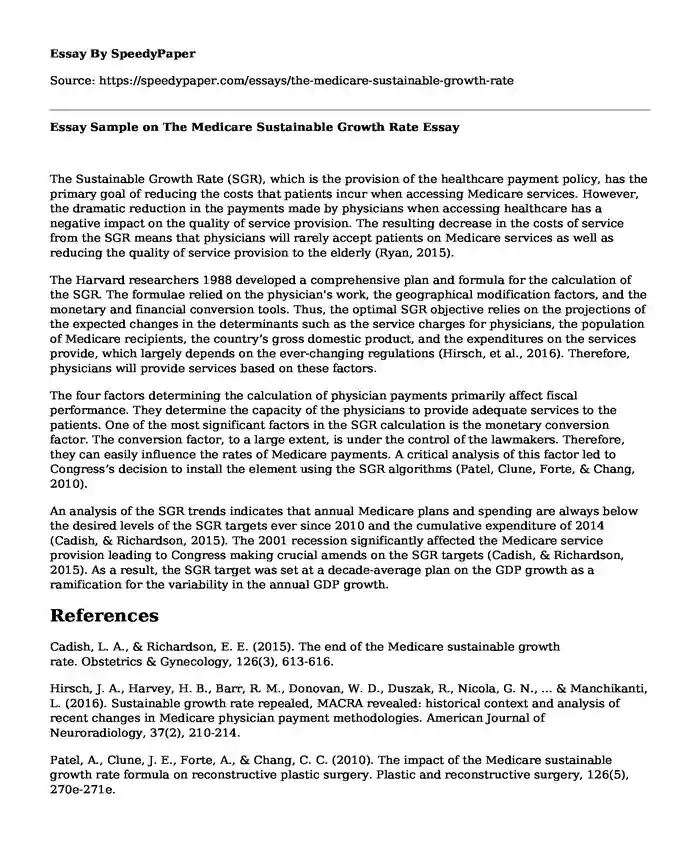
| Type of paper: | Essay |
| Categories: | Money Healthcare policy Public health Customer service |
| Pages: | 2 |
| Wordcount: | 459 words |
The Sustainable Growth Rate (SGR), which is the provision of the healthcare payment policy, has the primary goal of reducing the costs that patients incur when accessing Medicare services. However, the dramatic reduction in the payments made by physicians when accessing healthcare has a negative impact on the quality of service provision. The resulting decrease in the costs of service from the SGR means that physicians will rarely accept patients on Medicare services as well as reducing the quality of service provision to the elderly (Ryan, 2015).
The Harvard researchers 1988 developed a comprehensive plan and formula for the calculation of the SGR. The formulae relied on the physician's work, the geographical modification factors, and the monetary and financial conversion tools. Thus, the optimal SGR objective relies on the projections of the expected changes in the determinants such as the service charges for physicians, the population of Medicare recipients, the country’s gross domestic product, and the expenditures on the services provide, which largely depends on the ever-changing regulations (Hirsch, et al., 2016). Therefore, physicians will provide services based on these factors.
The four factors determining the calculation of physician payments primarily affect fiscal performance. They determine the capacity of the physicians to provide adequate services to the patients. One of the most significant factors in the SGR calculation is the monetary conversion factor. The conversion factor, to a large extent, is under the control of the lawmakers. Therefore, they can easily influence the rates of Medicare payments. A critical analysis of this factor led to Congress’s decision to install the element using the SGR algorithms (Patel, Clune, Forte, & Chang, 2010).
An analysis of the SGR trends indicates that annual Medicare plans and spending are always below the desired levels of the SGR targets ever since 2010 and the cumulative expenditure of 2014 (Cadish, & Richardson, 2015). The 2001 recession significantly affected the Medicare service provision leading to Congress making crucial amends on the SGR targets (Cadish, & Richardson, 2015). As a result, the SGR target was set at a decade-average plan on the GDP growth as a ramification for the variability in the annual GDP growth.
References
Cadish, L. A., & Richardson, E. E. (2015). The end of the Medicare sustainable growth rate. Obstetrics & Gynecology, 126(3), 613-616.
Hirsch, J. A., Harvey, H. B., Barr, R. M., Donovan, W. D., Duszak, R., Nicola, G. N., ... & Manchikanti, L. (2016). Sustainable growth rate repealed, MACRA revealed: historical context and analysis of recent changes in Medicare physician payment methodologies. American Journal of Neuroradiology, 37(2), 210-214.
Patel, A., Clune, J. E., Forte, A., & Chang, C. C. (2010). The impact of the Medicare sustainable growth rate formula on reconstructive plastic surgery. Plastic and reconstructive surgery, 126(5), 270e-271e.
Ryan, C. (2015). Explaining the Medicare Sustainable Growth Rate.
Cite this page
Essay Sample on The Medicare Sustainable Growth Rate. (2023, Aug 08). Retrieved from https://speedypaper.net/essays/the-medicare-sustainable-growth-rate
Request Removal
If you are the original author of this essay and no longer wish to have it published on the SpeedyPaper website, please click below to request its removal:
- Essay Example on Ricin as Bioweapons
- Can Starting School Later Help Improve Students Health? Essay Sample
- Essay Sample on Borderline Competency: Deciding About Major Heart Surgery
- Free Essay: Prevention and Management of Pressure Ulcers
- Free Essay Sample: Impact of Euro
- Paper Example - American Industries
- Setting Priorities: A Fundamental Nursing Ethics Component - Essay Sample
Popular categories




